West Nile, Zika, Coronavirus: This BU Researcher Is Taking On Some of the World’s Most Serious Viruses—and He Plans to Win
Virologist Mohsan Saeed’s research has the potential to save thousands of lives. His next focus: stopping mosquitoes from spreading disease
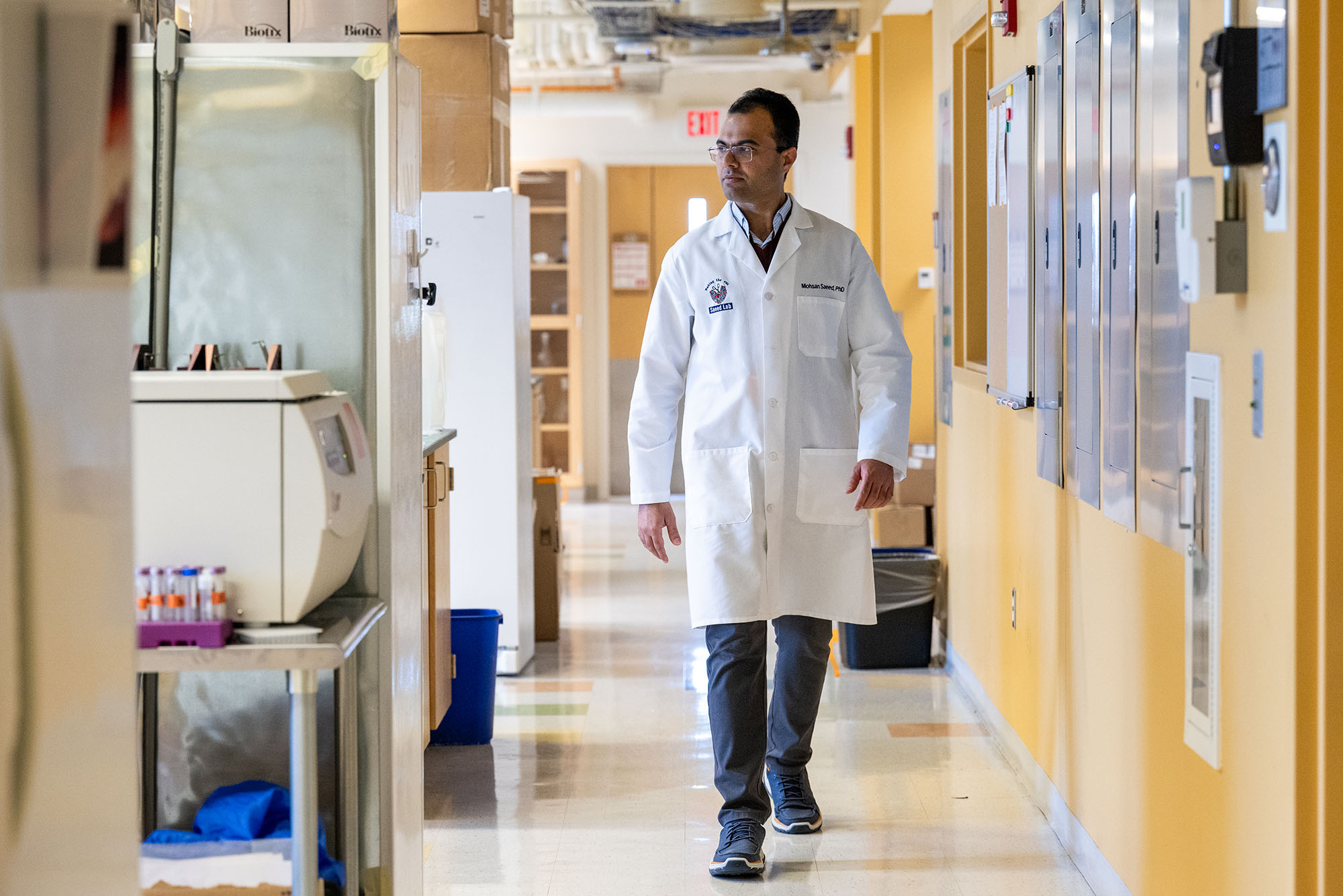
Mohsan Saeed, a BU Chobanian & Avedisian School of Medicine assistant professor of biochemistry and cell biology, works with viruses that cause some of the most serious diseases in the world. He and his team dive deep into the viruses to figure out how they work—and how to defang them.
West Nile, Zika, Coronavirus: This BU Researcher Is Taking On Some of the World’s Most Serious Viruses—and He Plans to Win
Virologist Mohsan Saeed’s research has the potential to save thousands of lives. His next focus: stopping mosquitoes from spreading disease
Mohsan Saeed joined Boston University in March 2019 and set to work right away setting up his lab. Saeed, a virologist, was all-in on studying highly contagious viruses that mostly affect children. As a group, they are called enteroviruses, and they go by names like Coxsackievirus, rhinovirus, and poliovirus, among others. In the United States, enteroviruses are responsible for hand, foot, and mouth disease, common colds, and, more rarely, polio.
Saeed’s lab, nestled within BU’s National Emerging Infectious Diseases Laboratories (NEIDL), was just about up and running by early 2020, when he got a curious email from NEIDL administrators: A journalist wanted to talk about a newly emerging pathogen that seemed to be gaining traction in China. Would Saeed consider taking the interview?
The request was a bit afield of the work Saeed intended to do at BU, but the request made sense. Saeed’s doctoral research at the University of Tokyo, as well as his postdoctoral research at the Rockefeller University in New York, focused on the hepatitis C virus. Both hep C and this new virus—thought to be a version of the SARS virus—are positive-sense RNA viruses, meaning that they use the same mechanism to replicate.
Saeed’s curiosity got the better of him, and he agreed to the interview. He read through the scant literature available on this strange virus that initially seemed no more (or less) concerning than the SARS outbreak in 2003, which infected some 8,000 people and killed about 800. He did the interview, and then went back to the time-consuming work of getting his research lab off the ground.
“That’s when all hell broke loose,” says Saeed, a BU Chobanian & Avedisian School of Medicine assistant professor of biochemistry and cell biology.
From the Clinic to the Lab
One interview quickly became two, four, a dozen. As the virus continued to spread, more and more people turned to Saeed to help make sense of it. He was reading every new scientific update about this virus, which we now call SARS-CoV-2, the coronavirus that causes COVID-19.
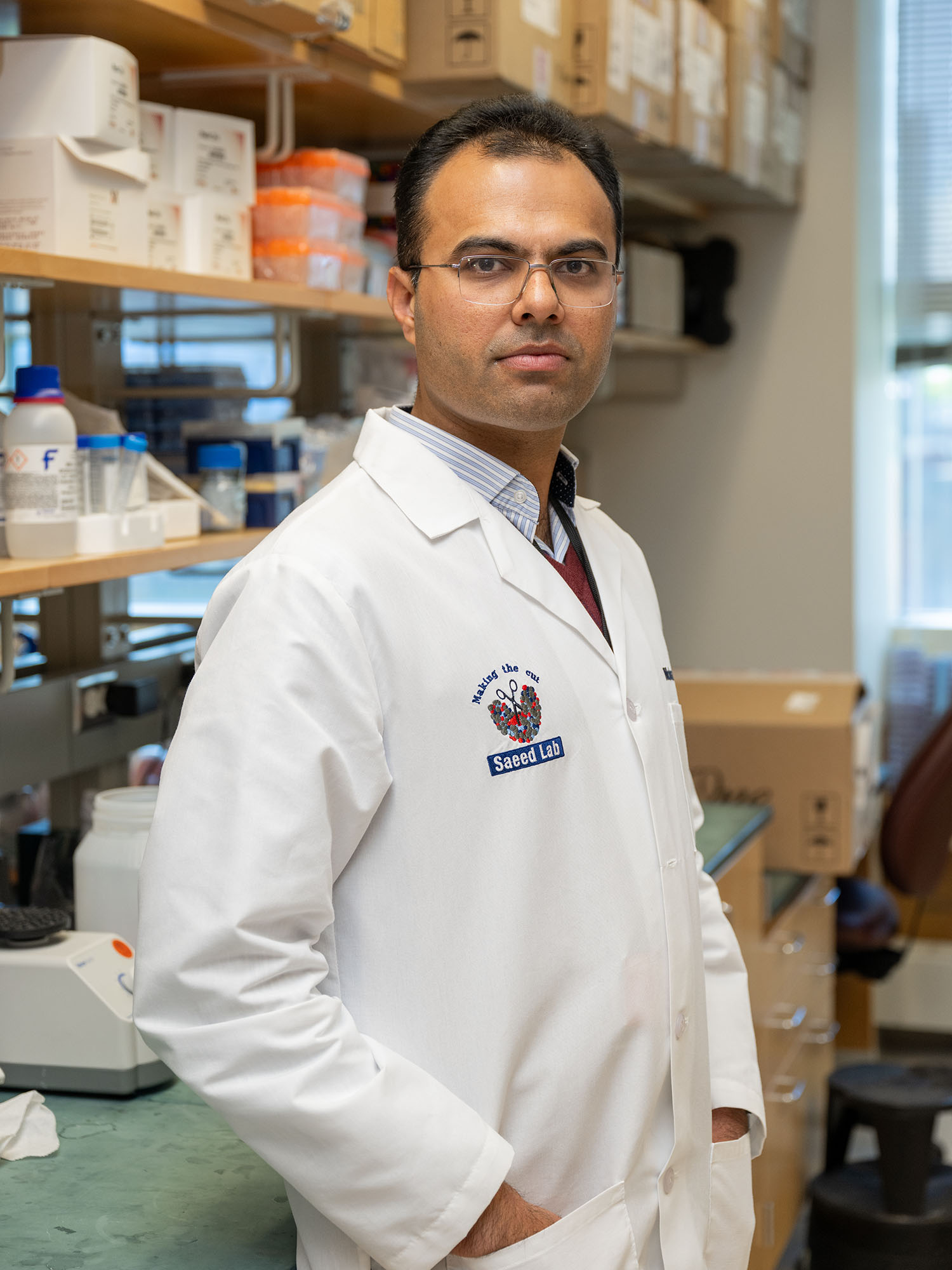
Saeed didn’t start out intending to study viruses at all; he had initially charted a course that would lead to becoming a medical doctor. In his native Pakistan, he dutifully added degrees that edged him closer to a career in the clinic—and even briefly considered practicing animal medicine—until he caught up with a friend who was studying the polio virus as part of his work at the country’s National Institutes of Health. Saeed was interested in his friend’s research, and took him up on the opportunity to visit the lab.
“Growing up in a country plagued with viral diseases and witnessing a family member live with the effects of polio immediately got me excited about the virus research,” Saeed says. “It has since fueled my determination to understand how viruses cause disease and uncover the best strategies for their cures.”
By March 2020, COVID-19 had become a full-blown pandemic, and BU—and pretty much every other major research institution—was shutting down most research labs, except those that were working with SARS-CoV-2 or had plans to. Saeed, who had poured a year’s worth of energy into hiring researchers, purchasing equipment, and applying for funding for the Saeed Lab, was determined not to let it all go to waste.
“We decided to make a switch,” he says. Given his background in positive-sense RNA viruses, “it didn’t really take a huge effort to pivot our research,” Saeed says.
He was already in the right place. BU’s NEIDL is a 192,000-square-foot, seven-story building that includes secure containment spaces for emerging infectious diseases research. On April 23, 2020, Saeed posted a photo of himself to X (then Twitter) in full personal protective equipment (PPE). A white Tyvek suit covers his entire body, and blue gloves and shoe covers cap off Saeed’s arms and legs. Only his face is visible through a clear plastic shield. His expression, smiling, looks like a mix of anticipation and trepidation—the kind of face you might make before crossing the threshold into a vast, unknown territory. “Our COVID-19 work begins today! Hope to contribute to the unprecedented global research effort,” he wrote.
Our COVID-19 work begins today! Hope to contribute to the unprecedented global research effort pic.twitter.com/yewKvaiUwA
— Saeed Lab (@drmohsan) April 24, 2020
Contributing to the Effort
For two years, Saeed and his colleagues were focused almost exclusively on SARS-CoV-2. By 2022, they’d published nearly 30 research papers, most of them directly related to some aspect of the pandemic.
“I came into contact with people in the field who had been working with coronaviruses for many years, and we were able to develop a lot of tools in the lab very quickly,” Saeed says.
They discovered a crucial pathway for developing more effective COVID-19 vaccines, and studied the cascading effects of COVID-19-related tissue inflammation and how SARS-CoV-2 overpowers human immune defenses.
The work—exacting, exhausting, and happening at breakneck speed, while a deadly pandemic raged on—was challenging. But, for someone who had dedicated his life to studying viruses, it also gave Saeed a larger purpose and, he hoped, would bring about greater recognition for his field.
“When the pandemic came along, I remember having conversations with some of my colleagues that maybe now people will value the importance of virology,” Saeed says. He remembers thinking that “there probably will be more support—not only from [the US National Institutes of Health (NIH)] in terms of funding and resources, but also from the general masses. Virologists should be empowered and enabled to really understand how viruses work, how they move from one species to another, how they make jumps from animals to humans.”
In other words, Saeed thought the pandemic might usher in an era when virology research would be given the attention those in the field long thought it deserved.
“But then, unfortunately, I was wrong on that front, and things totally went south.”
“One of the Most Difficult Days of My Life”
Toward the end of 2022, Saeed and his colleagues were notified that one of their COVID papers had been accepted into the prestigious journal Nature for publication. This was huge. It’s one of the world’s most highly respected scientific journals and one that Saeed says researchers can spend their whole careers trying to get into. So, to have their relatively young lab—at this point only three years old—recognized in its pages was a major achievement.
Saeed and his colleagues had been examining the spike proteins on the SARS-CoV-2 Omicron variant (BA.1). They were interested in comparing the variant with the original virus strain to figure out what part of the SARS-CoV-2 virus dictated how virulent it truly was. Ultimately, Saeed and his colleagues identified the mutations that helped Omicron dodge prior immunity and showed that a previously unheralded virus protein—known as NSP6—might be an essential factor in the variant’s lower disease-causing potential.
What made this research so notable was, in part, a technique Saeed and his colleagues used to study the virus. They developed a highly efficient method for reverse-engineering the virus, allowing them to learn more about its makeup and tinker with it one protein at a time to understand, in this case, what role the spike protein played in viral transmission. Only a handful of labs had this capability at the time, Saeed says, and his was one of them. It was an important step forward, one celebrated by the research community at BU and beyond.
Using this technique, the researchers tested different virus variants in mice that had been engineered to be highly susceptible to COVID-19, confirming that the virus’ spike protein played a significant role in the development of disease—but that it wasn’t the whole story.
When a draft of their paper—containing some early results, including the mice trials—was made public, Saeed says scientists at BU, NIH, and elsewhere reached out to congratulate him and his team for their elegant work.
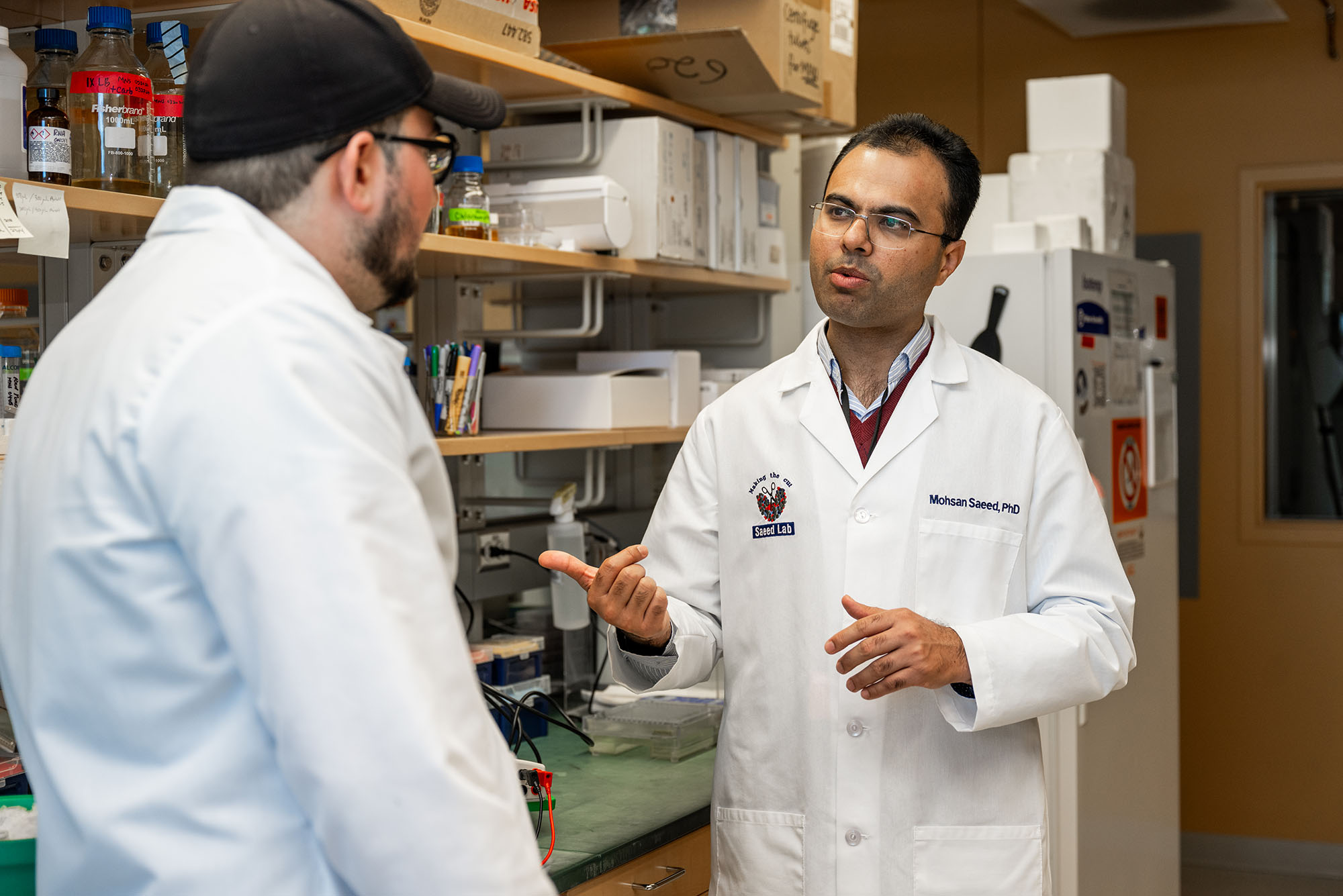
But that same draft also found its way into the hands of reporters at the Daily Mail, a United Kingdom–based tabloid, where it was vastly misreported.
Alarmist and incorrect headlines about researchers “creating a new deadly COVID strain” went, well, viral. The Daily Mail’s misinformation arrived at a time when people were increasingly isolated—with false anti-vaccine conspiracies running rampant and Americans’ trust in institutions (including the bureaucrats and scientists who worked at those institutions) near an all-time low. Saeed says he learned about his paper’s acceptance in Nature on a Friday, and by Saturday, his email inbox was filled with vitriol.
“On Friday, we were over the moon. And on Saturday, it was one of the most difficult days of my life,” he says. He worried about the violent threats he and his colleagues at BU were receiving.
The University quickly issued a statement condemning the false claims and correcting the record, affirming that, like all research at the NEIDL, the study followed the US Centers for Disease Control and Prevention’s biosafety guidelines and was subject to oversight by the Boston Public Health Commission and BU’s Institutional Biosafety Committee, which includes community members with no University affiliation. But Saeed says the harassment from misinformed outsiders lasted three or four weeks, even as media outlets, such as the Associated Press and Popular Science, began to report the facts.
Saeed says that what made the misinformed backlash even more difficult was that people weren’t critiquing his methods or asking questions about his findings, which is a healthy part of scientific dialogue—they were attacking his motives.
“People questioned the intention, not the quality of our work, but the intention,” he says. “That part’s very deep. When you’re doing something to help to understand what was going on, and then a big fraction of people are saying that, ‘Oh, this was done with some sinister and bad designs or bad intentions,’ that’s very difficult.”
The public discourse eventually quieted down. After Nature confirmed the research results following a period of vigorous review by other scientists, their final paper was published in January 2023. The publication capped a turnaround in people’s opinion about the paper, as well. The focus shifted away from false interpretations of the work seemingly meant to stoke fear and toward the true nature and importance of the researchers’ breakthrough. Saeed and his team finally got to celebrate, too. They went to a Japanese restaurant, Saeed says, a nod to his halcyon days in Tokyo working on his doctorate.
The Mosquito Problem
As the pandemic waned and life resumed its usual texture, the Saeed Lab gradually shifted its focus toward other viruses. At this point, Saeed estimates two-thirds of the research in his lab is focused on coronaviruses broadly (including those that cause seasonal colds), and the remainder on enteroviruses. Generally, Saeed says, he and his colleagues study how viruses interact with the human body.
There’s an inherent tension between a virus that needs to invade a host cell to replicate and the host’s cells, which need to defend against outside invasion in order to maintain a proper metabolic balance.
“For [the viruses], it’s a matter of their survival. So they employ various mechanisms to gain access to the cell. And the motivation for us is that if we can understand how viruses do it, then we can leverage that knowledge to develop therapeutics and to empower our cells to win that battle,” Saeed says.
He and his colleagues employ the technique they perfected—an efficient way to replicate viruses from their genetic material—to turn on and off the production of specific proteins in order to understand how those proteins function within the larger system of the virus.
At the end of 2023, Saeed was selected to receive the Smith Family Foundation: Odyssey Award, becoming the first person from BU to win it. The honor came with a $400,000 grant to study how mosquito-borne viruses (arboviruses) overcome the immune system of mosquitoes and establish persistent infection that is then transmitted to humans.
That research, still in its infancy, could prove to be an important step toward mitigating mosquito-borne illnesses, such as West Nile, dengue, and Zika. Using a highly secure insectary inside the NEIDL, Saeed and his colleagues will study live mosquitoes and mosquito cells infected with these viruses to understand how the viruses dodge the insects’ built-in defense mechanisms.
The insectary holds up to 2,000 mosquitoes, and researchers have to make their way through a series of containment barriers to get to their lab to study the insects. Infected mosquitoes are locked in double cages, while mesh and plastic cover every lab entrance. Researchers also keep bug zappers on hand as an added precaution. These biosafety measures allow the researchers—suited in Tyvek lab coats and N95 respirators—to study the arboviruses in depth.
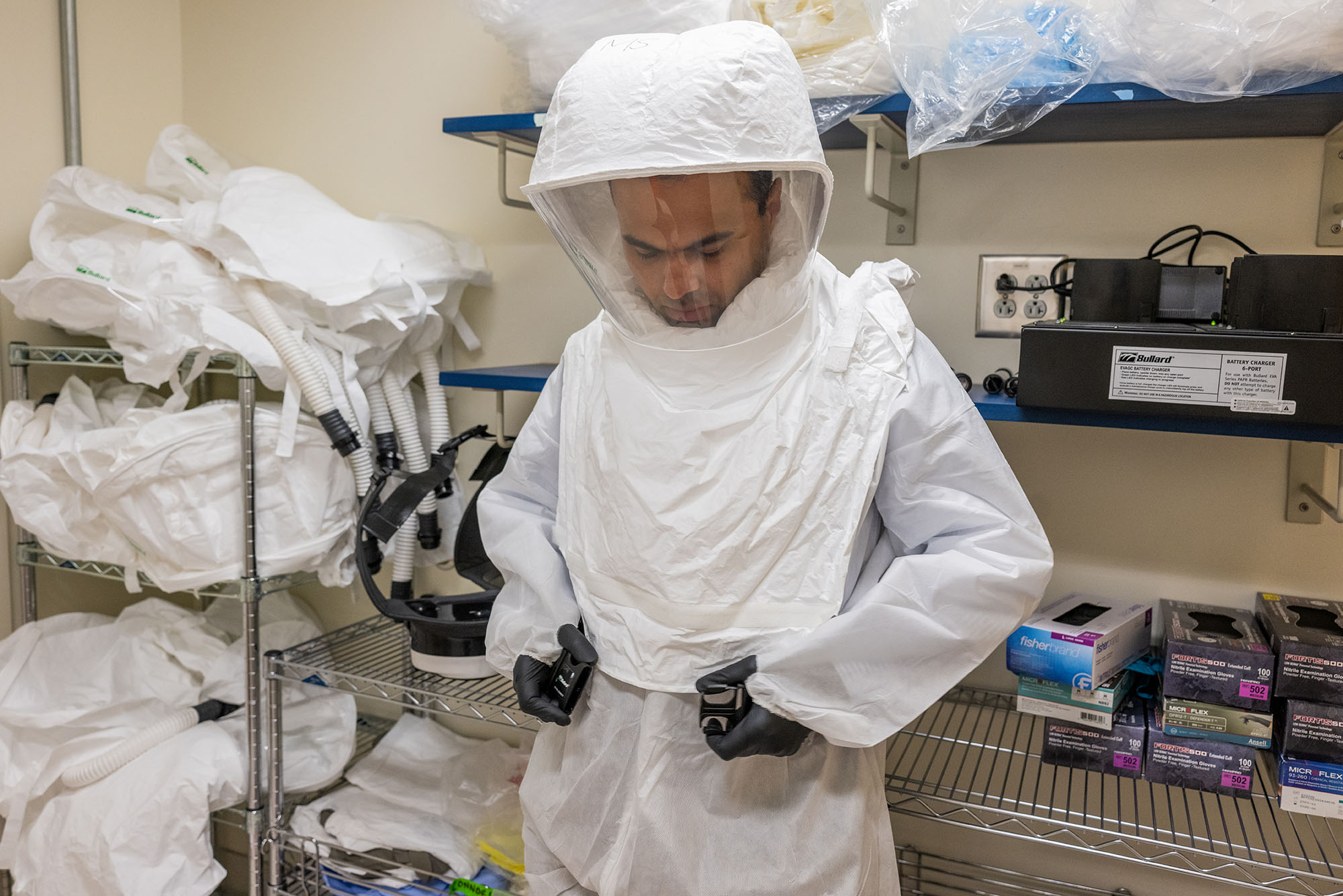
“When it comes to the ability of these viruses to evade or circumvent human defense mechanisms, that area has been explored quite extensively,” Saeed says. “But when it comes to their ability to overcome the mosquito defense system, that is where there are many barriers.” Saeed and his team plan to use the tools they fine-tuned when they were working with SARS-CoV-2 to overcome those barriers.
And, as climate change increases the global mosquito population and expands the geography where they live, the need to understand these potentially deadly viruses—and to create ways of making them less potent—only becomes more urgent, Saeed says.
His research may eventually help scientists develop more effective vaccines or mosquitoes less able to transmit arboviruses.
Describing a process that is already being tested in parts of the world, Saeed says, “You can make mosquitoes that do not have the ability to harbor the virus. Then, you can release those mosquitoes in huge numbers into a population with the hope that they will replace the existing population. That way, you can change the mosquito population and try to curb the spread of viral infection in that area.”
Focusing on the Science
West Nile, Zika, SARS-CoV-2—day in and day out, Saeed and his team work with viruses that can, and do, cause disease. It’s not a job for the faint of heart, and Saeed approaches it with a scientist’s methodical consideration.
Members of the team ensure they’re vaccinated against whichever virus they’ll be working with (if a vaccine is available). They wear full PPE, the components of which are carefully calibrated depending on the virus at hand. The individual labs all have what’s known as negative air pressure, meaning the air pressure inside the room is lower than outside, ensuring that air rushes in rather than out, so that no airborne virus can escape.
In order to even enter their lab, the fully vaccinated researchers have to go through a series of rooms and interlocking doors, donning multiple layers of protective gear, including an astronaut-like suit and hood.
The building itself, a glassy modern structure in Boston’s South End, was designed and built in accordance with the most stringent and protective specifications set by the government for conducting infectious diseases research. As the New Yorker reported, “barriers surround the site at a distance of a hundred and fifty feet from the building; they are fitted with motion-detection sensors and are strong enough to stop a fifteen-thousand-pound truck going fifty miles an hour.”
For Saeed, all of these precautions mean that he can just focus on the science.
“If you are a trained virologist,” Saeed starts, then takes a new tack: “I don’t really get afraid at all, because I have a lot of trust” in the strict safety precautions at the NEIDL, he says.
The mental game is present, though. Saeed says there were times early in the pandemic when he and his team would read reports of how many people had died from COVID-19 the day before. Maybe they even knew someone. And then they would report to work and again study the virus.
“So your mind goes in that direction and, yes, sometimes you do feel a little emotional attachment with that virus or with the projects that you are doing,” he says. “But I never felt afraid.” To this day, Saeed has never tested positive for COVID-19, he says, even during the period when BU was testing its students, faculty, and staff weekly. “During the whole pandemic, not a single instance,” he says.
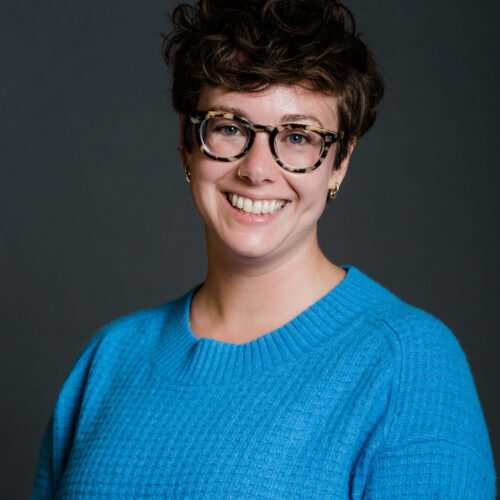
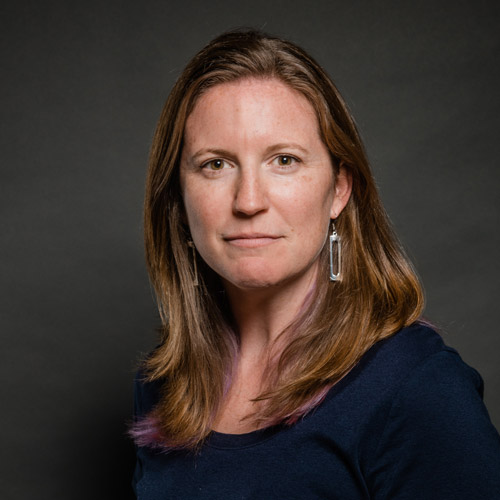
Comments & Discussion
Boston University moderates comments to facilitate an informed, substantive, civil conversation. Abusive, profane, self-promotional, misleading, incoherent or off-topic comments will be rejected. Moderators are staffed during regular business hours (EST) and can only accept comments written in English. Statistics or facts must include a citation or a link to the citation.